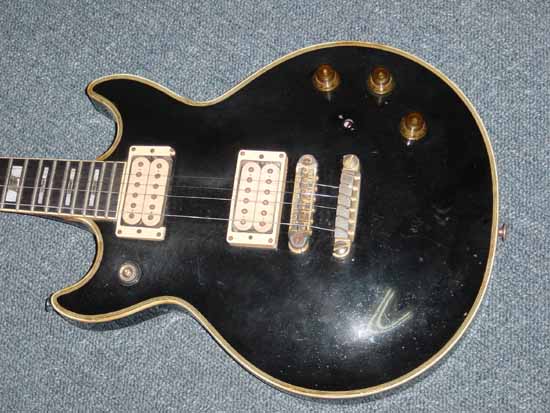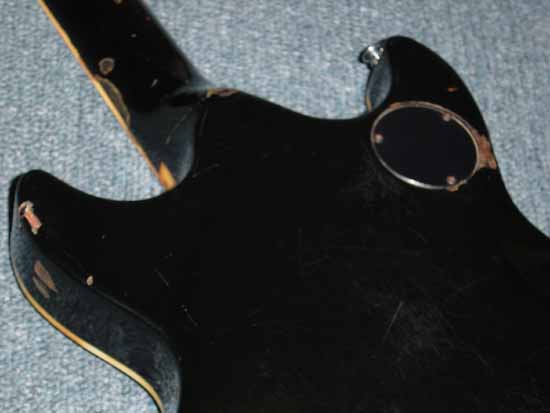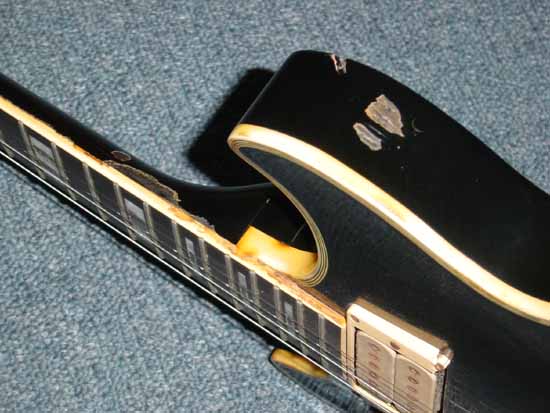|
| Author |
Message |
    
Meranti
Username: Meranti
Registered: 07-2001
| | Posted on Wednesday, July 27, 2005 - 7:40 am: | |
I was trading emails with John when I got a call from a seller locally asking if I was interested in an Ibanez Les Paul with block inlays. I asked what was the model and the reply was "AR2000"! Didn't made sense to me and further telephone exchanges came with the next description "shaped like a Les Paul but has a "bigger" hump". My initial thought was this was a Performer series.
It took some time before I got to see the guitar in person and you can see from the pics below, the only thing the seller got right was "block inlays" and "AR".
I think this is an AR-300 from the Idda Gaki era as the serial number is I900XXX (with pull pots). When the guitar was taken out of the cover, I almost fainted as this one really is in pretty bad condition.


If you see dots on the body and elsewhere, normally sellers will state that this is the effect of the flash. In this case, it is real dots or bubbles that seem to come out of the finish.


It is missing a knob and wired to work with one volume pot I have been told but I did not bother to check it out. It only had 3 strings left! Bridge has rusted.

The neck pup surround has broken off.

Look at the battle scars!

More scars!!

Even more scars!!!
I believe that this guitar can be restored and therefore I bought it.
The question here is would you buy it with this condition? If yes, how much would you pay for it?
The intersting points for me on this guitar are:
1. It was made at the Idda factory as explained by Jim Donohue on this site when Fuji stopped making setnecks.
2. The serial number does not seem to correspond to standard Japanese system of:
I900XXX where,
"I" = Idda,
"9" = year of manufacture = 1989?, and
"00" = month but this does not make sense.
Anyone can help?
Finally I was trying to look at the Ibanez book if there was a reference section on serial numbers and realised there wasn't any. Thanks for this site.
Regards,
Meranti |
    
Johns
Username: Johns
Registered: 02-2001
| | Posted on Wednesday, July 27, 2005 - 9:32 am: | |
Meranti:
Whew, that's baby's seen some rough treatment. Although you have stated before that the Indonesian climate is murder on guitars, this wouldn't be typical high humidity wear and tear, huh?
While I wouldn't expect to see the exact same specs for an Asian model, check out this 1990 catalog page:
http://www.ibanezrules.com/catalogs/us/1990/artist.jpg
I wonder if this isn't one of those elusive AR200s that one of the members has been clamoring about. The main difference between the 200 and 300 seems to be all mahogany vs. Maple/mahogany body, rosewood vs. ebony fingerboard, no name humbuckers vs. DiMarzio PAF Pros and the finish. So...pull the pups and sand down the black finish and tell us what you see. 
Interesting that your's has MOP/Abalone split blocks, like you'd expect to see on an AR300, but the 1990 catalog show plain MOP inlays. Also, no black finish is mention for the AR300. Differences that can easily be explained by the country of importation, I'd say. |
    
Bluepill
Username: Bluepill
Registered: 07-2004
| | Posted on Thursday, July 28, 2005 - 5:10 am: | |
hey maranti
i have seen that model in catalogues but cant find the link at the moment.
interesting that its not shown on the catalogue picture? anyway the model you have there was the top of the line at the time.
ive been trying to get an ar300 (no split inlay) for a couple of years in australia, where are you located?? avtually i think im the members that has been clamoring about em as john puts it 
as far as price, i found a guy in the states that was selling his (in good con) for $500..he had swaped the pickups out for dimarzio super 2's (being a qotsa fan) but was including the original pafs with it. how much did you pay??
by the way, ive never seen a guitar thats been more abused than that! someone needs a hiding |
    
Meranti
Username: Meranti
Registered: 07-2001
| | Posted on Thursday, July 28, 2005 - 5:43 am: | |
Whilst the weather does do serious damage on guitars here, this baby had actually suffered serious physical abuse. At least it has found a new home and will be well taken care of from now on.
I think this is an AR300 as the fingerboard is ebony. I will open up the pups etc and take some pics and post it here. However, I will be busy the next few days and can only do so next week. I will also be sending it for a refinish and restoration work can start after that. Captain Ibanez, I will be calling you soon for some parts. Hope you can help.
A question here is that I found the abalone inlays to be a bit rough (to the point of powdery feeling). Has anyone experienced this and any way to make it smooth?
Bluepill, I am based in Jakarta and I know when that location is mentioned it sends chills up some readers. I am not Indonesian but just happened to work here.
Price I paid for it? Less than US$200. Of course it did not come in a case. Would you have bought it? |
    
Ibanezfreak1960
Username: Ibanezfreak1960
Registered: 03-2004
| | Posted on Thursday, July 28, 2005 - 8:37 am: | |
Meranti ask Spiro about those inlays, he can help you out! |
    
Spiro
Username: Spiro
Registered: 02-2001
| | Posted on Thursday, July 28, 2005 - 5:41 pm: | |
Hey Chin Hon! What a great project guitar!!!
These are the guitars I like to buy.. and then fix em up!.
About the inlays.. Some abalone is not of the greatest quality so its starts to break up over time. it just breaks down to its calcium state.. The only way to stop it is to epoxy it up and try and save it.. Or replace it... Inlay work is costly though and could cost you upwards of $400 to reinlay a guitar because it will need a refret at the same time..
Just look throught those pics it seem that the guy who owned prior to you must of played with a full suit of Medieval armour on.. Its beat up like hell.
Another thing.. Stewmac has stopped supplying Celluloid binding altogether so if it were to be rebound it would have to be done in ABS binding which means you will lose the grained Ivoroid type binding on it.. Dont know how long LMI will keep selling ivoroid either.. because of 2 reasons.. 1 it deteriorates and it is illegal to send via airmail..
anyways still a nice project guitar.. possibly refinished in a custom colour??? |
    
Meranti
Username: Meranti
Registered: 07-2001
| | Posted on Thursday, July 28, 2005 - 11:55 pm: | |
Spiro,
Thanks for the input. This is not the first time I have faced the problem with the abalone inlay. I have another AR-300 with the same powdery feeling.
Yes, I thought this guitar can be restored and that was the reason I bought it. I hate to see this guitar going somewhere else and suffer more abuse. It is such a shame.
I was thinking about refinishing it to its original color and never thought about a custom color. Now you have got me thinking.
Regards,
Chin Hon |
    
Meranti
Username: Meranti
Registered: 07-2001
| | Posted on Friday, July 29, 2005 - 12:40 am: | |
Spiro,
Thanks for the input. This is not the first time I have faced the problem with the abalone inlay. I have another AR-300 with the same powdery feeling.
Yes, I thought this guitar can be restored and that was the reason I bought it. I hate to see this guitar going somewhere else and suffer more abuse. It is such a shame.
I was thinking about refinishing it to its original color and never thought about a custom color. Now you have got me thinking.
Regards,
Chin Hon |
    
Meranti
Username: Meranti
Registered: 07-2001
| | Posted on Friday, July 29, 2005 - 12:43 am: | |
Spiro,
Thanks for the input. This is not the first time I have faced the problem with the abalone inlay. I have another AR-300 with the same powdery feeling.
Yes, I thought this guitar can be restored and that was the reason I bought it. I hate to see this guitar going somewhere else and suffer more abuse. It is such a shame.
I was thinking about refinishing it to its original color and never thought about a custom color. Now you have got me thinking.
Regards,
Chin Hon |
|
|
Thank you for supporting Ibanez Collectors Forum. Please help your favorite Ibanez guitar site as we endeavor to bring you the latest information about Ibanez custom vintage electric and acoustic guitars. Here you can discuss ibanez, guitars, basses, acoustics, acoustic, mandolins, electric guitar, electric bass, amplifiers, effect pedals, tuners, picks, pickups.
|








